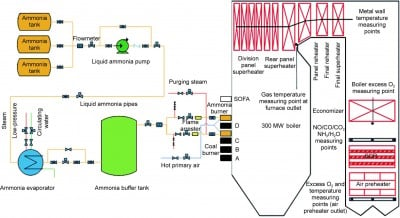A recent study from the Hefei Comprehensive National Science Center in China has introduced a promising technology aimed at reducing carbon emissions in coal-fired power plants. The research, published in the journal Engineering, focuses on ammonia co-firing in a 300-MW coal-fired power station, highlighting its potential to significantly lessen CO2 emissions.
The study, titled “Experimental Study on Ammonia Co-Firing with Coal for Carbon Reduction in the Boiler of a 300-MW Coal-Fired Power Station,” offers an in-depth analysis of how integrating ammonia with traditional coal combustion can lead to more sustainable energy production. This approach is particularly relevant as countries worldwide strive to meet their carbon reduction targets amid growing concerns about climate change.
Innovative Approach to Power Generation
According to the researchers, implementing ammonia co-firing can improve the environmental performance of existing coal-fired power plants. The study demonstrates that by blending ammonia with coal, it is possible to reduce the overall carbon footprint of energy generation without necessitating extensive modifications to existing infrastructure. This method presents a feasible solution for power plants in regions heavily reliant on coal.
The research highlights that ammonia, when combusted, releases nitrogen instead of carbon dioxide, thus providing a pathway to lower greenhouse gas emissions. The team conducted experiments to evaluate the combustion characteristics of ammonia in conjunction with coal, measuring the emissions produced during the process. Their findings indicate a substantial reduction in CO2 emissions, marking a significant advancement in the pursuit of cleaner energy alternatives.
Implications for the Energy Sector
The implications of this study extend beyond academic interest. As the global energy landscape shifts towards renewable sources, the need for cleaner technologies in traditional power generation becomes increasingly critical. The Hefei Comprehensive National Science Center’s findings could pave the way for the adoption of ammonia co-firing in coal-fired plants across the globe, impacting energy policies and strategies aimed at achieving net-zero emissions.
Industry stakeholders and policymakers may consider this technology as a viable option to transition from coal dependency while balancing energy demands. With coal still a primary energy source in many countries, integrating ammonia co-firing could serve as a bridge towards more sustainable energy practices.
As nations work to mitigate climate change effects, the research from the Hefei Comprehensive National Science Center represents a forward-thinking approach to reducing carbon emissions in one of the world’s most polluting energy sectors. The study’s findings could inspire future research and development, encouraging further exploration into innovative solutions for cleaner energy production.
